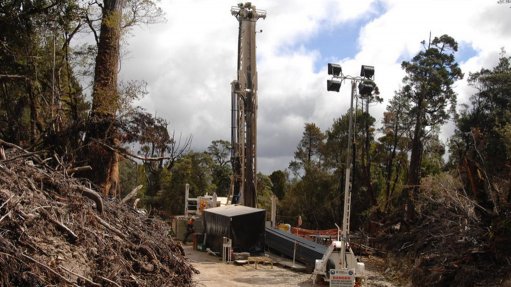
Name: Rosebery mine.
Location: The Rosebery mine is located in Tasmania, Australia, about 300 km north-west of Hobart and 1 205 km south of Burnie.
Controlling Company: MMG.
Brief History: The Rosebery deposit was discovered in 1893; however, it was not worked on a large scale until 1936, owing to the very fine grain size of the intimately combined sulphides. The underground mine is still in operation today, with an expected mine life beyond 2020. The mine has previously been operated by several other companies, including Electrolytic Zinc, Pasminco, Oz Minerals and Zinifex, and recently taken over by MMG.
The mine has the capacity to produce an estimated 700 000 t/y of ore.
Brief Description: Rosebery is an underground polymetallic base metal mine and one of the longest and deepest mines currently operating in Australia.
The Rosebery mine lease includes the Rosebery, Hercules and South Hercules base and precious metal mines.
Products: Zinc, lead, copper, gold and silver.
Geology/Mineralisation: Rosebery comprises more than 50-million tonnes of massive to disseminated sulphide.
Sphalerite, galena, pyrite, chalcopyrite, electrum (gold containing silver) orebodies strike north-north-east and dip 43º to the east, hosted in a sequence of felsic volcaniclastics.
Resources: Total measured, indicated and inferred resources, inclusive of the ore reserve, for the Rosebery deposit as at June 2014, were estimated at 17.2-million tonnes, grading 11.3% zinc, 3.6% lead, 0.4% copper, 123 g/t of silver and 1.7 g/t of gold.
Total measured, indicated and inferred resources, inclusive of the ore reserve, for the South Hercules deposit as at June 2014, were estimated at 700 000 t, grading 3.8% zinc, 2% lead, 0.1% copper, 165 g/t of silver and 3.1 g/t of gold.
Mining Method: Rosebery is a mechanised long-hole, open-stope underground operation, with footwall ramp access. The mine currently employs a benching mining method, but has historically also used a cut-and-fill stoping method.
Major Infrastructure and Equipment: The Rosebery crushing circuit consists of a primary jaw crusher and a secondary cone crusher.
The grinding circuit comprises two primary ball mills and three secondary ball mills.
Gravity gold is recovered from the grinding circuits using two Knelson concentrators.
Gold concentrates are leached in an intensive leach reactor and recovered from the pregnant leach solution by electro- winning and thereafter the gold sludge is smelted.
Concentrates are pumped to the filter plant where they are filtered using Larox filters.
Prospects: Following the completion of drilling at Lake Rosebery and White Spur, and underground drilling into the Marionoak domain, exploration drilling was suspended at Rosebery in the middle of the year. The focus of exploration then shifted to regional structural interpretation and mineralisation and alteration studies.
Contact Person: Senior communications adviser Martin Powley.
Contact Details:
MMG,
tel +61 7 4769 5395,
email martin.powley@mmg.com, and
website http://www.mmg.com.